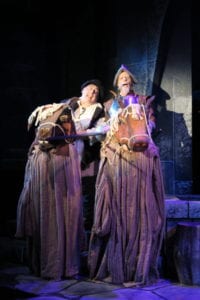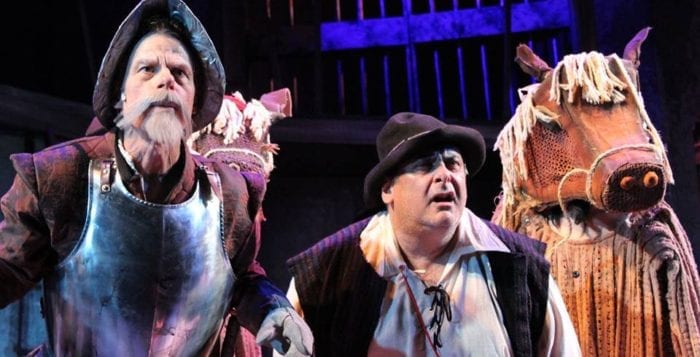By Kyle Barr
In the conflict between cynical realism and colorful idealism, “Man of La Mancha” is fully in support of the latter even while being so close to giving into the former. It is a production that teeters on this line even in the most silly of circumstances, and it is this fine line that requires quite a lot from everyone involved from music to set design to acting so that the meaning does not get confused.
It is good then that the Smithtown Center for the Performing Arts is up to the challenge.

While classic productions like “Man of La Mancha” (a 1960s Broadway production ran for over 2,000 performances) give local theaters the opportunity to perform something familiar, these shows can have the side effect of giving the impression that it is “amateur hour.” However, the SPAC, even on its opening night, not only manages to have a show with great performances on every level, but it also manages to capture the depth and heart of the play.
The story first centers upon the “bad poet and idealist” Miguel de Cervantes who, along with his manservant, is arrested by the Spanish Inquisition under the charge of foreclosing on a church. In prison, all their possessions are taken by the other inmates, including the tough yet sympathetic “Governor,” who declares they will put on a mock trial for Cervantes and that if he is found guilty everything including his precious manuscript will be taken or burned.
The aging gentleman declares he wishes to present his trial in the form of a play about a man named Alonso Quijana, who has become so fed up with the evil of the world and has spent so much time around books on ancient chivalry that he goes insane, dons a breastplate and helmet and makes himself a knight errant named Don Quixote. He has the other inmates act out characters throughout his defense, all while time is ticking down before he must meet his real trial in front of the Inquisition.

What is remarkable about the production, and what director Kenneth J. Washington and the other folks at the SPAC have managed to convey, is how well the theme and meaning builds over time. At first the audience must agree with the inmates, thinking Cervantes is an idiot idealist who has little excuse for his actions. Slowly it is clear through the obtuse silliness of Don Quixote that Cervantes might have a point, and eventually it is clear the production is a metanarrative about theater and fiction itself.
It is a theme expressed even by the set design, headed by resident designer Tim Golebiewski. At first the set seems well designed, with good work on the foreground and the paintings of stonework that seems truly lifelike. But it all seems a little dull and gray, easily blending into each other.
However, this works to the play’s themes. The audience is there inside this dungeon, and just like the inmates the place is dull and harrowing. Once Don Quixote is on stage, running around with broken lance and bent sword, both inmates and audience imagine a more colorful scene much in the way that Quixote seems to imagine it. It is all enhanced by lighting designer Chris Creevy who does a fine job on the subtle hints of lighting to fit the scene.
Of course, this setup would not work at all unless the actors convey that they too are being transported into Cervantes’ world, and on opening night last Saturday the entire cast went above and beyond what was expected.

While actors are often expected to play multiple parts on the stage throughout a play, lead Michael Bertolini has the harder job of switching between Cervantes, Quixote and Quijana often in the middle of a scene. Nevertheless, he manages it flawlessly, with each character having a distinct presence on stage. Cervantes is composed and gentlemanly, while Quixote is loud, boisterous while cripplingly old. It was a joy to watch Bertolini put on makeup right on stage, quickly transforming himself into another character in a scene only usually reserved for behind the stage.
SPAC veteran Brianne Boyd, who plays Alonsa, the kitchen wench of the local inn, fills her roll with a great melancholy that is pitch perfect, not to mention her voice that captures that loneliness and hopelessness especially in her song “It’s All the Same,” which musical director Melissa Coyle and choreographer Danielle Nigro must have spent countless hours getting just right. The song stands out as the most memorable and affecting number of the entire production.
The other standouts of the cast are easily Stephen Treglia as the manservant Sancho Panza, the unflappable sidekick to both Cervantes and Quixote, and Steve Ayle, his first time at the SPAC, as both the Duke and Dr. Carrasco, who has a stern face when talking of the merits of cynicism and realism over idealism.
If you have never seen “Man of La Mancha,” then SPAC’s production is a great introduction to the magnificent story. If you have seen La Mancha before, then this is a good way to remember why you loved it so much.
The Smithtown Center for the Performing Arts, 2 E. Main St., Smithtown will present “Man of La Mancha” through Oct. 22. Tickets are $35 adults, $32 seniors, $20 students with valid ID. To order, call 631-724-3700 or visit www.smithtownpac.org.





